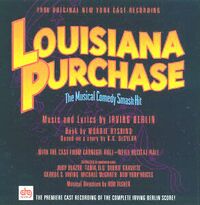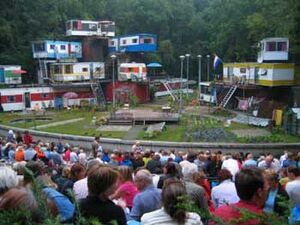Louisiana Purchase

The Louisiana Purchase refers to the biggest diplomatic rip-off in history. For millions of dollars, the Federal Government of the United States decided in a smoke-filled back room to buy millions of acres of land, sight unseen. In the process, the USA gained from France a huge swath of land prone to hurricanes, blizzards, bad Cajun food, the SEC and tornadoes, all of it filled with angry Mexicans and Native Americans. And the worst part was the United States didn't bother to obtain any kind of warranty, being assured by the salesman, Joe Jones Smith of "Paris" that it was a little used but still in great shape. Historians are unanimous about the result: With the stroke of a pen, France dumped a vast wasteland into America's backyard, and was paid for the privilege. Today, when you hear about hurricanes tearing apart New Orleans, or tornadoes devastating St. Louis, or you read about historical Indian massacres on the Great Plains, you can thank the Louisiana Purchase.
Origin of the Purchase
In the late 1700's, world events set the stage for one of the most intriguing swindles in the annals of history. The fledgling United States, fresh from the War of Colonial Aggression against Great Britain, was running out of room for expansion in its original 13 colonies on the eastern seaboard of America, and even in the nearer Northwest Territories, which had been ceded by the British Crown. Still, the colonial cowards were not strong enough to face their former masters in a second war over Canada, nor could they challenge the empire of Spain for the land called Texas to the southwest. This left the United States with a large problem: how to obtain much needed land without fighting for it?
Enter France. By the early 1800's, the new leader of France, Napoleon Bonaparte, was embroiled in a war against Prussia, Russia, and England, and desperately needed money to fund his conquest of Europe. At the same time, he knew France owned some land called "Louisiana" and "Québec" down somewhere in the southern and middle portions of the continent of North America. He wasn't using the land and assessed it as worthless. So he decided to sell it to the gullible Americans for millions of dollars.
Details of the Purchase
Napoleon sent his best negotiators to the USA to broker the Louisiana Purchase. By the end of the week-long sales talks, the French had convinced the Americans that there were cities of gold on the plains of Kansas, and that the resident Native Americans would readily embrace Christianity and settle down into gold-mining colonies for the benefit of the Americans.
Some of the American negotiators were doubtful. Benjamin Franklin was not even sure what the United States was buying. "They call it 'Louisiana,'" he quipped, "but I'm pretty sure that northern part that borders Canada is not Louisiana." Other Americans had their doubts as well. John Adams wondered about the neighboring Mexicans, saying out loud, "Don't they think they own a bunch of this "Louisiana" you propose to sell us?" The French quelled such concerns by promising they would return and beat down the Mexicans if there were any problems. (They did this in the 1860's, but only after the United States fought and won a war with Mexico in the 1840's. And still, unlike the Americans, the French ended up ultimately losing to the Mexicans.)
So it was that the Louisiana Purchase went forward in 1803, as follows: the USA acquired 828,800 square miles of France's claim to the territory of Louisiana for a total sum of 15 million dollars for the Louisiana territory ($15.29 in 2010 dollars). The Louisiana Purchase encompassed all or part of 15 current U.S. states. The land purchased contained all of present-day Arkansas, Missouri, Iowa, Oklahoma, Kansas, Nebraska, parts of Minnesota that were west of the Mississippi River, most of North Dakota, nearly all of South Dakota, northeastern New Mexico, northern Texas, the portions of Montana, Wyoming, and Colorado east of the Continental Divide, and Louisiana west of the Mississippi River, including the city of New Orleans (parts of this area were still claimed by Spain at the time of the Purchase). The purchase, which doubled the size of the United States, comprises around 23% of current U.S. territory (undoubtedly, the worst 23%).
Aftermath of the Purchase
It soon became clear that the United States had not entered into the best bargain, and buyer's remorse set in. Here are some of the reasons:
Whoops - Indians!
Once the Americans read the fine print of the purchase documentation, they realized that what they had purchased was France's claim only, not the actual territory, which belonged to the tribes which inhabited the area. Because of this, the USA was forced to conquer the territory itself slowly throughout the nineteenth century by purchases from Native American tribes and wars. For example, the United Stated was forced to fight Sitting Bull and his Red Army Choir for almost 100 years during the Indian Wars on the Great Plains. The Americans ultimately won, but the Native Americans have had their revenge by setting up gambling operations and casinos on their reservations, addicting countless Americans to gambling in the 21st Century, and enriching the Native Americans at their expense.
Whoops - Mexicans!
Again reading the fine print just a bit too late, the Americans realized that part of the "Louisiana Territory" was actually part of New Mexico and Texas, which belonged to Spain at the time. Once Spain lost its North American territories to the new sovereign nation of Mexico by 1820 or so, the United States found itself confronting a foreign power for the right to possess land it had already purchased from France. Not such a good deal. In fact, the United States ended up losing a small part of the territory when an island in the northern Rio Grande River broke away and formed the new nation of "New and Improved Mexico" in the 2000's.
Whoops - Tornadoes and Hurricanes and Blizzards!
Once American settlers started moving west of the Mississippi River to live in "Louisiana," they quickly learned that the USA had purchased a shit-hole. There were no trees, no natural resources, angry Indians, cataclysmic storms (tornadoes, hurricanes, blizzards) and a host of other problems to contend with. Settlers never occupied any of the Louisiana-purchase acquired territories in the same proportion that they settled other lands, because the land was (and remains) miserable.
Whoops - Trailer Trash!
The miserable conditions stated above thus led to a phenomenon called "trailer trash." Those white settlers who were willing to endure the harsh landscape, terrible weather, and (rightfully) hostile natives developed genetic mutations and became a sub-race of humanity all their own. There is evidence, however, that they have begun to develop into something approaching a true "society" in the past decades - that is, if they can overcome the thousands of hurricanes and tornadoes that destroy their schools, homes, and livelihoods every year.
Whoops - Sarah Palin!
OK, she wasn't born there, but she shared so many common cultural values with the citizens of the region (see Trailer Trash above) that she ran right down as soon as she was old enough to stick her silk-stocking clad leg out and "hitch-hike a ride" (see Double Entendre Day) to Baton Rouge. She then discovered that she could still see Russia from her house, and on top of that could now see Mexico as well.
An Historical Retrospective
Many Americans look back now on the Louisiana Purchase as one of the greatest and most mysterious swindles of international diplomacy. Most of the land obtained was not even "Louisiana," but instead consisted of places like Kansas (where everything is black-and-white) and North Dakota (a wasteland if ever there was one). This conclusion is borne out by the fact that most people who have chosen to live in the purchased areas do not even bother with permanent settlements, but instead erect "trailer parks" that serve as magnets for the approximately 46,000 tornadoes that strike the region every year.
The greatest reminder of the foolishness of the bargain came in 2005, when Hurricane Katrina hit Louisiana and inflicted $56 billion worth of damage to the region. The United States put in a warranty claim to France for the damage, which the French ignored. Instead, it was the Mexicans of all people who sent troops and peacekeepers to help the Americans rebuild. All in all, the Louisiana Purchase was a poor decision by a young American government that has learned from experience what it could not learn from textbooks: don't buy crappy land; instead, take good land by force.
See Also
| Featured version: 22 October 2011 | |
| This article has been featured on the main page. — You can vote for or nominate your favourite articles at Uncyclopedia:VFH. | |




